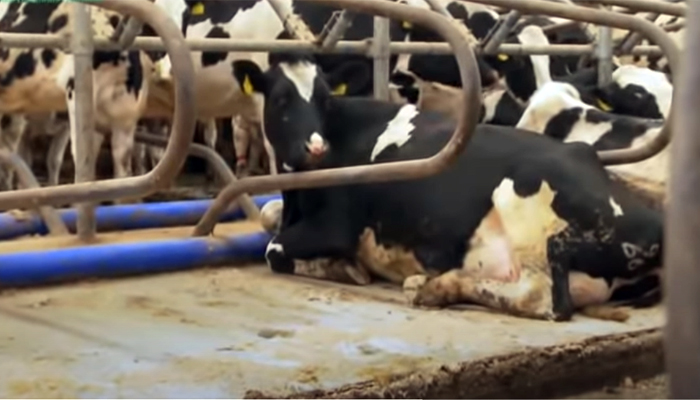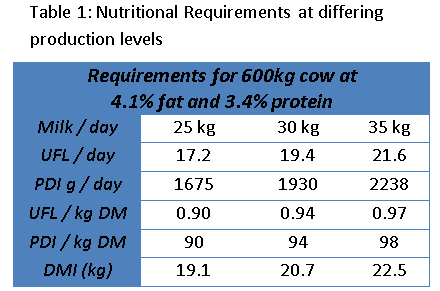01 November 2021
Feed plan for winter milk herds

Creating a winter feed plan that delivers the best economic return has always been well debated but never more than now given the 20% increase in concentrate costs in the last number of months. James Dunne, Dairy Specialist, Teagasc Ballyhaise has advice on feeding the freshly calved cow this winter
The plan needs to take into account available forage quality, herd milk yield and calving pattern (proportion of stale versus fresh cows). Fresh cow diets should promote high milk solids production and good body condition to improve fertility all while ensuring stale cows are fed appropriately for their yield thus maximising feed efficiency at a whole herd level.
There are 3 important steps:
1. Get your forage analysed to establish nutrient content and intake potential
2. Formulate a diet that balances energy, protein, fibre requirements plus minerals
3. Use milk recording records/calving dates to assign cows to correct feeding levels
What are the cow’s requirements?
 When it comes to diet formulation, Table 1 outlines what the typical autumn calving cow requires at differing daily milk output levels. Dry matter intakes of 20-22.5kg are required to meet nutrient demand. Quality forage is essential; target at least 60% of DMI as forage (13 to 14kg per day). Balance of DMI as concentrate. Energy is the first limiting nutrient for milk, diet UFL per kg is constrained by the need for fibre in diet. Meet the target UFL per kg with high quality forage and hi-energy concentrates. High UFL energy per kg promotes good milk solids and body condition. Ensure you provide enough total PDI (protein) for target production. To maximize efficiency of energy and protein utilisation for milk production it is important to match the PDI and UFL ratio of the diet. When the diet is balanced for protein fractions (PDIN and PDIE are similar) total crude protein level can be reduced to 15.5% (from the standard 17.5%) as a result, saving on feed cost.
When it comes to diet formulation, Table 1 outlines what the typical autumn calving cow requires at differing daily milk output levels. Dry matter intakes of 20-22.5kg are required to meet nutrient demand. Quality forage is essential; target at least 60% of DMI as forage (13 to 14kg per day). Balance of DMI as concentrate. Energy is the first limiting nutrient for milk, diet UFL per kg is constrained by the need for fibre in diet. Meet the target UFL per kg with high quality forage and hi-energy concentrates. High UFL energy per kg promotes good milk solids and body condition. Ensure you provide enough total PDI (protein) for target production. To maximize efficiency of energy and protein utilisation for milk production it is important to match the PDI and UFL ratio of the diet. When the diet is balanced for protein fractions (PDIN and PDIE are similar) total crude protein level can be reduced to 15.5% (from the standard 17.5%) as a result, saving on feed cost.
For example: a diet with 0.94UFL per kg should have 94-97g PDI. A total diet NDF (fibre) target of 30-36% will maintain rumen health and avoid acidosis, 24-28% should come from forage; silage DMD and intake achieved dictate overall diet NDF. However excess NDF (>40%) from poor forage sources or straw reduces DMI and milk yield. Use quality digestible fibre sources if forage intake/quality is limited.
Forage quality dictates the level of concentrate required
 The benefits of higher DMD silage are well proven; improved forage intake, more milk solids, greater milk from forage, better rumen health and lower concentrate feeding levels. Table 2 outlines the concentrate feeding levels required for different levels of milk output depending on the silage quality available. For example the typical 600kg cow will require 7.5kg of concentrate to produce 30kgs of milk whereas that requirement would be 10.0kgs should the silage be 65 DMD.
The benefits of higher DMD silage are well proven; improved forage intake, more milk solids, greater milk from forage, better rumen health and lower concentrate feeding levels. Table 2 outlines the concentrate feeding levels required for different levels of milk output depending on the silage quality available. For example the typical 600kg cow will require 7.5kg of concentrate to produce 30kgs of milk whereas that requirement would be 10.0kgs should the silage be 65 DMD.
Typically every 5 unit drop in DMD will need 1.0 – 1.5kg extra concentrates to compensate for the lower energy level. Good quality forage makes it easier to meet UFL intake targets.
Johnstown Castle Winter Diet
For the Johnstown Castle winter milk herd, the aim is to have a good quality base diet that will work well for high yielding and lower yielding groups alike. This simplifies feeding in the yard. The parlour is used to top up the high yielding group with additional concentrate.
The feed ingredients used for the basic milking diet are:
- 9kg DM of good quality grass silage (74% DMD)
- 5kg DM of high quality maize silage (33% starch)
- 3kg of a high protein (23% crude protein) coarse blend fed as part of the forage mix (this contains barley, soybean, beet pulp and distillers grains)
This diet provides enough nutrients for approximately 20kg high solids milk as a base level. Lower yielding cows receive a further 2kg parlour ration. Fresh cows receive up to 6kg additional parlour concentrate bringing their daily dry matter intake to 21.5kg on average. This covers the fresh group with enough energy (UFL) and protein (PDI) for a group average milk yield of 31.5kg, which is our target for December/January. Parlour concentrate is formulated for high energy at 18% crude protein equivalent and contains full minerals and vitamins.
The Teagasc Dairy Specialists issue an article on a topic of interest to dairy farmers every Monday here on Teagasc Daily.
Learn more about the Johnstown Castle dairy farm here. Find more on Teagasc Dairy here.
